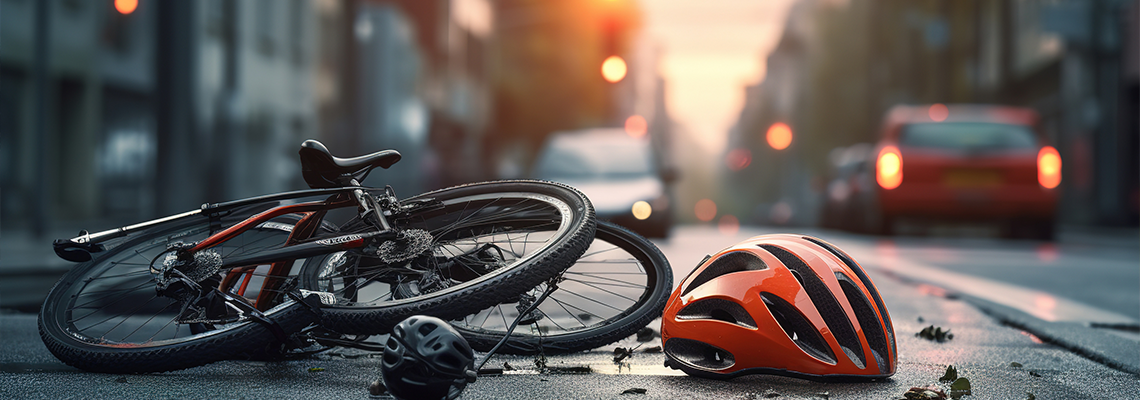
Legal Challenges When a Cyclist Collides with a Distracted Pedestrian
Urban environments pose significant risks for cyclists and pedestrians. With increasing density and distractions, accidents involving bicycles and distracted pedestrians are on the rise. While vehicle accidents are often anticipated, cyclist and pedestrian collisions can result in serious injuries and raise legal questions about responsibility.
At The Eskesen Law Firm in New York, New York, I am dedicated to helping injured individuals navigate these challenging situations. When you need a bicycle accident attorney in New York, I can help guide you through every phase of your claim.
Common Causes of Cyclist–Pedestrian Collisions
Collisions between cyclists and pedestrians rarely result from a single factor. Instead, the common causes often involve numerous parties who may share portions of fault. It's important to understand these causes to help you establish a foundation for pursuing legal action. Some of the common causes of cyclist–pedestrian collisions include the following:
Distracted pedestrians: Pedestrians using smartphones, listening to music through headphones, or engaging in conversations are less likely to notice a nearby cyclist. Unexpected changes in direction or stepping into crosswalks without looking can surprise even the most attentive rider.
Cyclist negligence: Cyclists have an essential responsibility to follow the rules and watch out for hazards. Riding too fast, ignoring traffic lights, or failing to yield at crosswalks can put pedestrians at risk. On multi-use paths, safe speeds and full attention help avoid close calls that can lead to injury.
Environmental and external conditions: New York can be visually crowded, with delivery vehicles, street vendors, and construction sites limiting lines of sight. Weather adds another layer of challenge, which make stops harder and visibility worse. Low lighting or glare from headlights at night can also increase accident risks regardless of experience.
Determining Fault in Cyclist–Pedestrian Accidents
To establish who is legally responsible for a cyclist–pedestrian accident, you will need to look closely at everyone’s actions and choices before, during, and after an incident. Some of the key factors you will need to consider include the following:
Right of way: Pedestrians almost always have the right of way in crosswalks, but stepping into bike lanes outside of these areas can assign partial liability to the pedestrian.
Obeying traffic laws: Cyclists who ignore stop signs or ride outside designated areas may be found at fault. Similarly, pedestrians who jaywalk or use crosswalks against signals may also be partly liable.
Immediate actions: Following an accident, both parties should check for any injuries and seek immediate help from medical professionals and law enforcement. Delays or incorrectly handling the situation can complicate or weaken later claims.
It's important to note that New York follows a comparative negligence rule. In cyclist–pedestrian accident cases, a court or insurance company will assign fault percentages to each party. If you are found to be partly at fault, you can still recover damages. However, your recovery will be reduced by your share of responsibility.
What to Do After a Cyclist-Pedestrian Accident
If you or someone you know has been involved in a cyclist–pedestrian accident, it's essential to know what to do immediately after the collision. Therefore, it's important to take specific steps that can help protect your health and rights.
Check for injuries and seek help: Your health and safety should be your main priority. More out of harm's way if possible and call law enforcement and emergency services.
Exchange information: Gather the names, contact details, and insurance info of all parties involved in the accident.
Document the scene: Take pictures of the accident scene, including your injuries, the bicycle(s), and visible damages.
Gather witness details: If someone saw the accident, ask for their contact information and note what they observed.
Keep records: Store copies of the police report, your medical documents, repair bills, and any related communications. These will serve as key evidence if you decide to pursue legal action.
Accidents with multiple witnesses, security cameras, and detailed police reports often provide strong support for one side or the other. However, conflicting stories and limited evidence can make claims more challenging. This highlights the importance of contacting a knowledgeable bicycle accident attorney as soon as possible.
What Evidence Strengthens Your Accident Claim?
Detailed documentation can significantly support your claim, especially when there are conflicting stories. Therefore, it's important to collect and organize the following items to better strengthen your claim:
Photos of the scene: Take pictures of the weather, lighting conditions, traffic signals, street layout, and any injuries you sustained.
Medical evaluations: Even if your injuries appear minor, get checked by a licensed medical professional who can provide detailed diagnosis reports and records of ongoing medical treatment.
Written statements: Ask any witnesses to write down what they saw as soon as possible after the accident and obtain their contact information in case you need to get in touch with them in the future. This can serve as key evidence in legal proceedings.
Correspondence: Save any texts, emails, and letters with insurance companies, repair shops, or medical providers.
Being proactive and thorough with your records often makes a meaningful difference when disputes arise. An experienced attorney can help you understand what evidence to obtain and how to organize it effectively.
Potential Compensation Following a Cyclist-Pedestrian Accident
If you've been injured in a cyclist–pedestrian accident, it's common to face medical expenses, time away from work, and costs related to rehabilitation or property replacement. Therefore, knowing the types of compensation available and documenting each expense can support your financial recovery. The common types of compensation you may be eligible for include:
Medical bills: This commonly includes emergency room visits, surgeries, rehabilitation, and therapy sessions.
Lost wages: If recovery takes time, you may be able to include documented salary losses in your compensation claim.
Pain and suffering: In some cases, you may be able to pursue compensation for emotional distress or permanent impact on your quality of life.
Repair or replacement: You can commonly claim damaged bicycles, electronics, or personal property as part of the damages.
Be sure to provide your bicycle accident attorney with all related invoices, receipts, and medical statements so you can work together to build the strongest claim possible.
Cyclist–Pedestrian Accidents FAQ
Can a pedestrian sue a cyclist for injuries?
Yes, pedestrians may file claims against cyclists if negligence can be shown. If a cyclist speeds, fails to yield, or engages in careless riding, injured pedestrians may recover damages like medical bills and lost wages. In extreme cases, punitive damages may apply if gross negligence is involved.
Are cyclists required to carry insurance for such accidents?
In New York, cyclists don’t need liability insurance. Still, some homeowners’ or renters’ policies may cover legal liability if a claim is filed. If insurance doesn’t apply, individuals may have to pay damages directly.
Can a cyclist sue a pedestrian under New York law?
Cyclists hurt by a pedestrian’s actions, such as someone stepping off a curb while distracted, can pursue a legal claim. Similar to pedestrian claims, responsibility is usually divided based on both parties’ actions leading up to the collision.
How does New York’s comparative negligence rule apply?
Under New York law, comparative negligence allows all parties to recover damages, but awards are reduced according to each party’s contribution to the accident. For more legal details, you can review New York’s comparative fault rules directly from the New York State Senate.
When should I seek legal help?
It’s wise for either party to consult a bicycle accident attorney after a crash. Deadlines, strategy, and documentation requirements can be easier to manage with early advice. Timely action helps preserve evidence and strengthens your potential case.
Contact an Experienced Attorney Today
Being injured in a cyclist–pedestrian accident can often be overwhelming. In New York, due to the crowded streets and dense population, these types of accidents are more common. If you’ve been involved in a bicycle accident, I am ready to offer legal support tailored to your needs through The Eskesen Law Firm.
Located in New York, New York, I represent clients throughout Kings County, Queens County, New York County, Bronx County, and Richmond County. Contact me today to schedule a consultation and discuss your situation.
